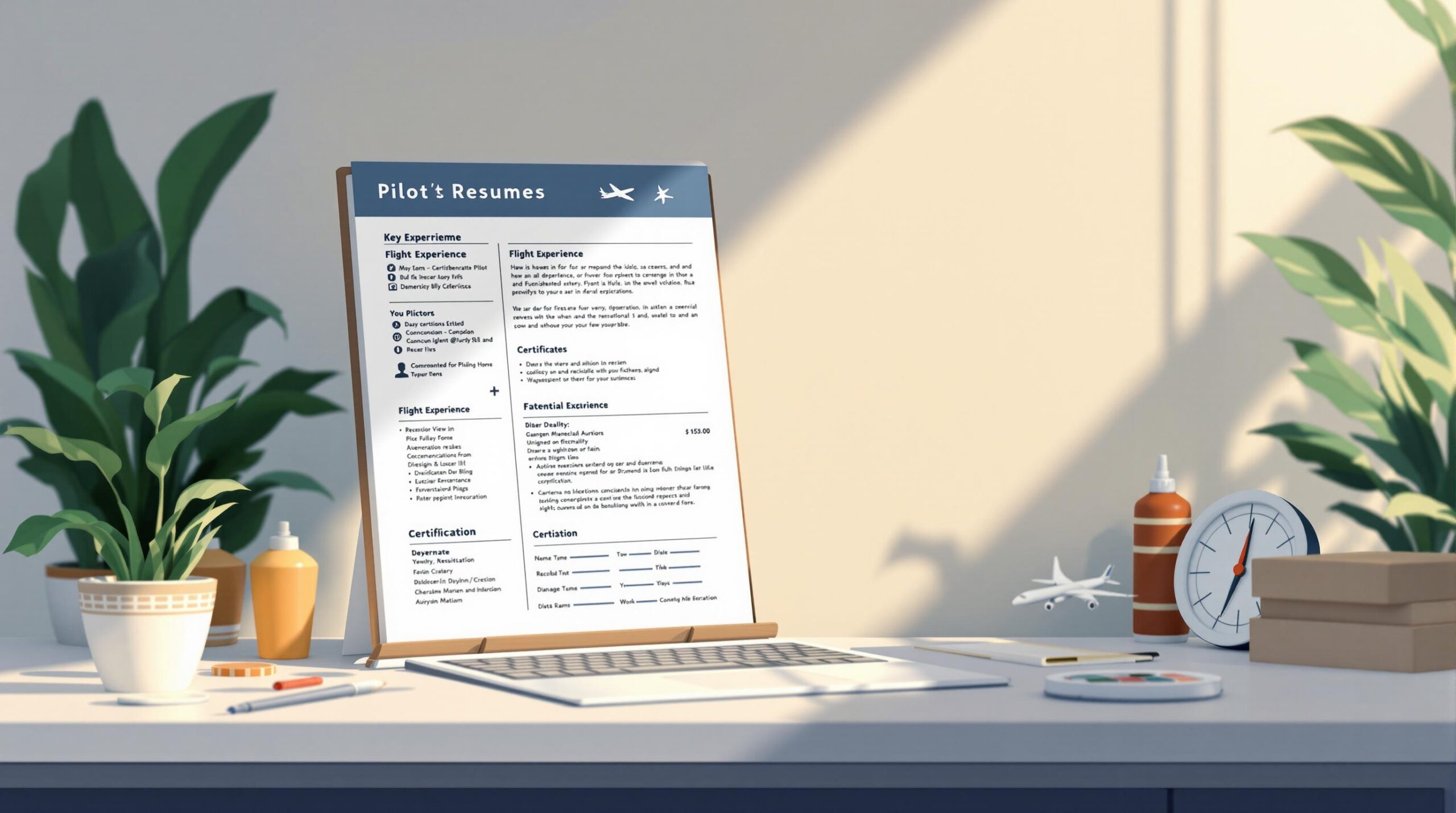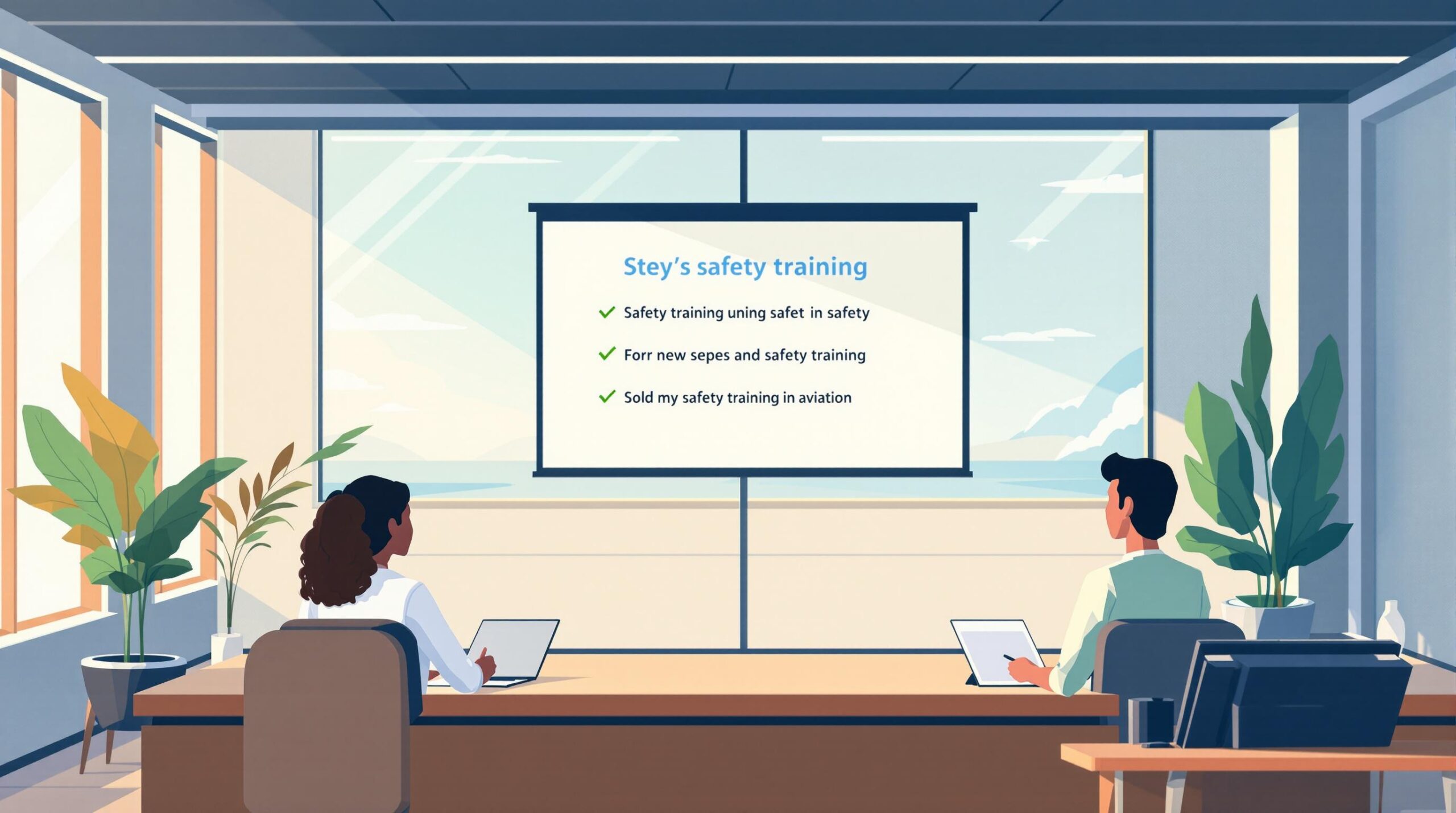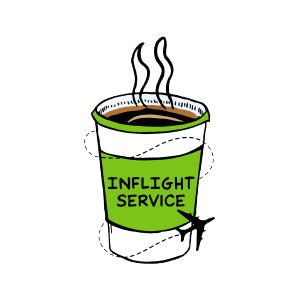Crafting a pilot resume that gets noticed is all about showcasing your flight experience, certifications, and technical skills in a clear, concise format. Here’s what you’ll find in this guide:
- Commercial Airline Pilot Resume: Highlights extensive flight hours, type ratings (e.g., B737, A320), and key qualifications like ETOPS certification and CRM training.
- Corporate/Private Pilot Resume: Focuses on executive transport experience, international operations, and client service skills. Includes type ratings for jets like Citation X and G550.
- Military to Airline Pilot Resume: Translates military experience into civilian terms, emphasizing leadership, multi-engine hours, and international operations.
Quick Comparison
| Resume Type | Key Features | Ideal For |
|---|---|---|
| Commercial Airline | High flight hours, type ratings, domestic/international routes, CRM skills | Major/Regional Airlines |
| Corporate/Private | Executive transport, client service, international expertise | Private Aviation Roles |
| Military to Airline | Leadership, complex aircraft, multi-crew, international operations | Transitioning Military Pilots |
Use these examples to structure your resume, focusing on certifications, flight hours, and relevant experience to stand out in the competitive aviation job market.
The Complete Pilot Resume: Everything You Need to Know
Example 1: Commercial Airline Pilot Resume
Here’s a sample resume for a commercial airline pilot, designed to showcase flight experience in a format preferred by leading U.S. carriers.
Main Resume Sections
The resume starts with a professional summary emphasizing 7,500+ total flight hours, including 5,000 hours as Pilot in Command (PIC) on Boeing 737 aircraft. Key certifications are prominently featured at the top:
| Certification/Rating | Date Obtained | Details |
|---|---|---|
| ATP Certificate | Jan 2020 | Multi-Engine Land |
| Type Ratings | 2020-2025 | B737, A320 |
| First Class Medical | Mar 2025 | No Restrictions |
| FCC License | Current | With Radar Endorsement |
This clear presentation ensures that essential qualifications stand out right away.
The next section breaks down flight hours by category:
- Total Time: 7,500
- PIC: 5,000
- Multi-Engine: 6,800
- Turbine: 6,500
- Cross Country: 4,200
- Night: 1,200
- Instrument: 2,800
Layout and Organization
The resume uses a clean, single-column format that makes it easy to read and evaluate. Work experience is listed in reverse chronological order:
Current Position: First Officer, Southwest Airlines (2020–Present)
- Aircraft: Boeing 737-700/800
- Routes: Domestic and select international (Mexico, Caribbean)
- Special qualifications: ETOPS certified, Cat III approaches
- Additional responsibilities: Crew resource management instructor
Previous Position: First Officer, Regional Carrier (2018–2020)
- Aircraft: Embraer E175
- Routes: Regional operations throughout the eastern U.S.
- Training accomplishments: Top performer in initial qualification
The resume also includes a section on training and education, detailing coursework, simulator experience, dates, and key skills. This comprehensive approach ensures all critical qualifications are covered.
Example 2: Corporate and Private Pilot Resume
This corporate pilot resume highlights essential skills and certifications tailored for private aviation roles.
Key Skills and Certifications
| Qualification | Details |
|---|---|
| Flight Hours | Extensive total time, significant PIC experience, including international operations |
| Type Ratings | Citation X, G550, Falcon 2000; certified for RVSM and RNP-AR |
| Operational Expertise | Proficient in CAT II/III approaches |
| Languages | Fluent in French and Spanish; certified in cultural awareness |
These credentials showcase a strong background in executive transport.
Executive Transport Experience
- Oversees Gulfstream G550 and Citation X fleet for a financial services firm (2022–Present)
- Manages global charter services
- Provides transport for C-suite executives and board members
- Developed safety protocols that improved operational efficiency
International Operations
- Extensive experience with trans-Atlantic and trans-Pacific flights
- Familiar with major European routes (Paris, London, Frankfurt)
- Skilled in Caribbean and South American operations
Focused Format for Private Aviation
This format highlights critical elements for corporate aviation, emphasizing safety, client service, and technical expertise.
Safety Record
- Maintains an incident-free flight history
- Experienced in implementing Safety Management Systems
- Knowledgeable in IS-BAO Stage III compliance
- Instructor for emergency procedures training
Client Service
- Skilled in managing high-net-worth client relationships
- Proficient in VIP security protocols
- Experienced with customs and immigration processes
- Coordinates ground transportation seamlessly
Technical Proficiencies
- Expertise in international flight planning
- Accurate weight and balance calculations
- Efficient fuel planning strategies
- Advanced weather analysis skills
This resume balances professionalism with a clear demonstration of technical knowledge and a strong commitment to safety in corporate aviation.
sbb-itb-de05b1b
Example 3: Military to Airline Pilot Resume
This resume focuses on helping military pilots frame their experience in terms that civilian airlines prioritize.
Converting Military Experience
Military pilots need to reframe their skills and experience to align with commercial aviation standards. Here’s a guide to translating military terms into civilian equivalents:
| Military Term | Civilian Translation |
|---|---|
| Mission Commander | Pilot in Command (PIC) |
| Aircraft Commander | Captain/First Officer |
| Combat Hours | International Operations |
| Formation Lead | Multi-crew Experience |
| NATOPS Instructor | Flight Instructor |
Flight Experience Translation
- Reclassify military aircraft into civilian categories (e.g., C-17 as Heavy Transport).
- Focus on instrument hours and handling complex weather conditions.
- Highlight experience with multi-engine aircraft and advanced systems.
- Showcase international operations and expertise in border-crossing protocols.
These strategies help military pilots present their experience in a way that aligns with commercial airline expectations.
Leadership and Technical Skills
After translating flight experience, emphasize leadership and technical abilities that match airline requirements:
Command Experience
- Planning and executing missions.
- Managing resources, enforcing safety protocols, and handling emergencies.
- Coordinating and leading crews effectively.
Technical Proficiencies
- Expertise in navigation systems and aircraft systems management.
- Proficiency in performance calculations and weather radar interpretation.
- Experience with high-altitude operations.
Transferable Qualifications
- Meeting ATP certification standards.
- Instrument and category/class ratings.
- Knowledge of special use airspace operations.
- Proficiency in Crew Resource Management (CRM).
Tools like Pilot Pathfinder can assist in accurately converting military experience into civilian aviation terms.
Resume Writing Tips
Key Elements for Success
When crafting your aviation resume, focus on these critical areas:
Format and Structure
- Stick to the standard layout expected in the aviation industry.
- Use clean, professional fonts like Arial or Calibri, sized between 11–12 points.
- Make use of clear headers and ample white space for better readability.
- Keep your resume concise – no more than 2 pages.
Content Placement
- Place key details like flight hours, certifications, and type ratings at the top.
- List Type Ratings immediately after your license information.
- Group similar aircraft types together for clarity.
- Highlight your currency requirements status prominently.
Organizing Information
- Break down flight hours by category and list certificates in reverse chronological order.
- Present certifications and training in a clear, chronological format.
Take the time to refine how you present your flight hours and certifications to meet industry standards.
How to Present Flight Hours
Suggested Format for Flight Hours
| Category | Recommended Format | Example |
|---|---|---|
| Total Time | Total Hours (PIC Hours) | 4,500 (3,200 PIC) |
| Type-Specific | Aircraft/Hours/Role | B737: 2,800 hrs – Captain |
| Special Conditions | Category/Hours | Night: 850, IMC: 420 |
Organize your flight experience into these categories to align with airline expectations:
- Primary Categories: Include Total Flight Time, Pilot in Command (PIC), Second in Command (SIC), Cross-Country, Night Hours, and Instrument Time.
- Aircraft-Specific Details: List hours for each specific aircraft type, keeping simulator time separate.
- Recent Experience: Highlight activity from the last 12 months, current type ratings, recent training dates, line checks, and proficiency reviews.
Certification Details
When listing certifications, ensure you include:
- ATP Certificate number and the date it was issued.
- Expiration date for your Class 1 Medical certificate.
- Your currency status for specific operations.
- Any special authorizations, such as RVSM or RNP.
Consider using tools like Pilot Pathfinder to sync your logbook data automatically, ensuring accuracy and consistency across your resume.
Resume Building Tools
Creating a pilot resume today often involves using software designed to simplify the process of organizing flight hours, certifications, and experience in formats preferred by airlines. One standout option is Pilot Pathfinder, which offers a range of features tailored for aviation professionals.
Pilot Pathfinder Features

Pilot Pathfinder provides tools to help pilots craft polished resumes:
- Automated Resume Builder: Generates resumes formatted to meet airline-specific standards.
- Logbook Integration: Imports flight hours and categorizes them by aircraft type, role, and flight conditions.
- Military Conversion Tool: Translates military flight data into civilian-friendly terminology.
For those who opt for the Pro plan ($29/month), additional features include:
- Interview Preparation Resources: Access a dedicated channel to help you get ready for interviews.
- Auto-Fill for Airline Applications: Use a browser plug-in and web app to streamline filling out airline application forms.
These tools work in tandem with the resume tips mentioned earlier, helping you present your qualifications in a clear and professional manner.
Conclusion
A strong pilot resume highlights your flight experience in a way that grabs attention. The examples we’ve discussed show how resumes for commercial airlines, private aviation, and military transitions each need a customized touch.
Here’s a quick rundown of what to focus on:
- Format: List your total and PIC flight hours prominently at the top of your experience section.
- Certifications: Make sure your licenses, ratings, and type ratings are easy to spot near the top.
- Tailored Content: Adjust your resume to fit the specific role, whether it’s commercial, corporate, or a military transition.
- Technical Skills: Specify the aircraft types, avionics systems, and technologies you’ve worked with.
- Safety Record: Highlight your safety qualifications, clean record, and any relevant statistics.




